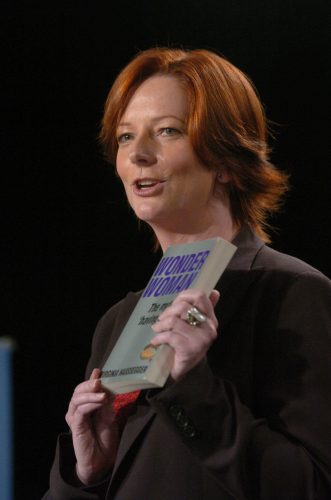Choosing a career can be tough. For the ambitious American bombshell, Alison Waite, it was real tough, as she explained to the Australian media earlier this week. She’d just finished graduate school when her first nude centerfold was published in Playboy. “I thought, well, what do I do? Medicine or the Mansion?” She chose the Mansion.
Apparently entry to Hugh Hefner’s Playboy Mansion is a lot easier than applying for medicine. (But that’s not why she did it – of course.) All she had to do was swindle her way into Playboy’s party of the year, and strike up a conversation with Kimberly, “one of Hef’s ex-wives”. And from there, it all just happened. Now she is a resident of the Mansion and officially ranks as Heffner’s fourth girlfriend, after Holly, Kendra and Bridget.
Whilst Alison’s academic attributes are not immediately obvious, her female ones certainly are. With luscious, large breasts propped up on enough whale-bone scaffolding to sink a Japanese ship, this bunny has her most persuasive assets clearly on display.
Although the Channel 7 morning show host – who this week dribbled and bounced from foot to foot as he interviewed her – didn’t need any persuading. He couldn’t stop jigging, as his sidekick female host shrilled and cooed and tried to calm him down, until the centerfold used a word Bouncing Boy couldn’t comprehend. She was describing how she’d like to “parlay” her Playboy status “into super stardom like Pamela Anderson”. He turned to his sidekick and said, “You better take over this interview because I don’t know what parlay means.”
Now, a lot could be said about morning television hosts and perky puppets with over-active giggle buttons, but frankly they’re not that interesting. However, the bunny girl is.
What exactly is this creature? A busty sex toy with a furry tail? An infantile woman seduced by a male fantasy in which females play together in lavish pens, like childish, cuddly pets? Is she a sexy opportunist, with an unhealthy fixation on father figures?
Or is the bunny girl really an embodiment of 21st century female empowerment?
Alison Waite and her fellow bunnies may argue that they enjoy squealing, posing and pouting. They may love their quaint, corseted bunny costumes and their big floppy ears. And perhaps they like being sexual fodder for men, because they’re proud of their titillation talents. If pushed, they may even pretend to like those leathery kisses the 82-year-old Heffner slops on their cheeks as he kneads their breasts. They may tell you how busy they are and what hard work it is to be a Playboy bunny. After all, Waite is in Sydney this week to launch a new bra, and the media commitments are endless.
They’ll tell you a whole lot of things about how great the bunny life is, and no doubt a gaggle of young girls will listen and wish they could be bunnies too. All that glamour, wealth and celebrity. It’s intoxicating.
To the simple-minded, to be physically adored and fawned over is to be liberated. Perverted as that may be. Just as when I once asked a former Miss Summernats runner-up how it felt to hear the male audience bellow “show us ya tits”, and “get it off”, Miss Nat said it made her feel “beautiful”. Her eyes truly glowed as she told me how wonderful it was to hear so many boys calling her name and cheering her on. The fact that she was barely a “she”, but rather a walking sexual stimulant in stilettos, didn’t seem to occur to her. Some girls just so desperately want to be wanted.
And bunny girl Alison Waite knows that there’s a certain power in being the object of wanting. She knows she makes most men turn weak and strong men even weaker. And let’s face it, there’s a certain power in that. But is it empowering?
Just as women no longer agree on what is and isn’t sexist, nor can we agree on what constitutes power. Particularly when it comes to the very vexed issue of female power.
Such confusion about female empowerment is what sucked many media in to running stories about the Playboy bunny’s Aussie visit.
No so long ago this story wouldn’t have appeared in an Australian newspaper or on TV. Back in the ’90s no-one would have dared run an interview with a semi-naked woman in an absurd bunny corset who’s here to plug Playboy bras. Not because the media was more prudish in the past. But simply because the story, and the interviewee, lacked legitimacy. Back then, the representation of women as pets for parading wouldn’t have stood up to scrutiny. The audience and the media programmers wouldn’t have allowed it.
So why are we now?
It would be easy to suggest that the answer is simply that we’ve moved on: that we’re less hung-up, and the PC police are all dead. But that’s a lazy response.
More common, and much worse, is the suggestion that what was once considered belittling and demeaning of women (such as pouting as an infantile pet) is now considered empowering. And yet this is precisely what women (and not men) are arguing in their defence of Playboy bunny culture, and its myriad offshoots in raunch culture.
The Playboy brand was nearly snuffed out during the surge of second-wave feminism. That its singular and archaic view of female sexiness is enjoying a resurgence, and that the enterprise is more profitable than ever, should sound an alarm to all dormant feminists.
But it seems we all have our fingers in our ears. And our eyes wide shut.





